By the end of the 1937-38 season, Warner Brothers cartoons were looking and sounding much like we would expect them to look and sound. Both the Looney Tunes and Merrie Melodies series had acquired their long running theme songs, “The Merry Go Round Broke Down” and “Merrily We Roll Along.” And even the steel guitar glissando was in place by early in the 37-38 season. The electric steel guitar was a fairly new-fangled instrument, having crossed over from Hawaiian music to stylized sweet bands such as Orville Knapp, Sammy Kaye, and Horace Heidt featuring Alvino Rey, as well as Texas Hot Swing Bands such as Bob Wills or the Light Crust Doughboys.

Speaking of the Weather (9/4/37) – Midnight on the magazine rack, utilizing every pun Frank Tashlin and his writers could think of, as well as the inevitable chase ending Warners’ had known and loved in so many past cartoons. Look for the interesting insertions by the background department in the sequence involving the Thin Man. His own book is credited to “Dashall Hemlock” instead of Dashell Hammett. At 5:28, story credits appear on a magazine listing “Melvin Millar – I. Freleng – Volney White – R. Wolfe”. Best of all appears at 5:33 – “Mystery Magazine”’s featured story is “Vengeance of the Inbetweeeners”!
Songs: the “William Tell Overture – The Storm”; “Summer Night”; “Speaking of the Weather” (introduced in Gold Diggers of 1937 by Dick Powell, who got to record it for Decca as a vocal, and also recorded by Rudy Vallee for Melotone and the dime store labels, and for Victor by George Hamilton and the Veloz and Yolanda Dancing Music – a band who accompanied the exhibition dancers Veloz and Yolanda on their ballroom and night club circuit, inheriting such post from Shep Fields and copying as much of his style as possible); “September In the Rain” (introduced by James Melton in “Melody For Two” and recorded by Guy Lombardo for Victor, among others, and also revived in a 1946 jazzy version by Frankie Laine and in the late 1950’s by a more mellow Dinah Washington); and “With Plenty of Money and You” (performed in the cartoon as a Bob Burns bazooka solo).
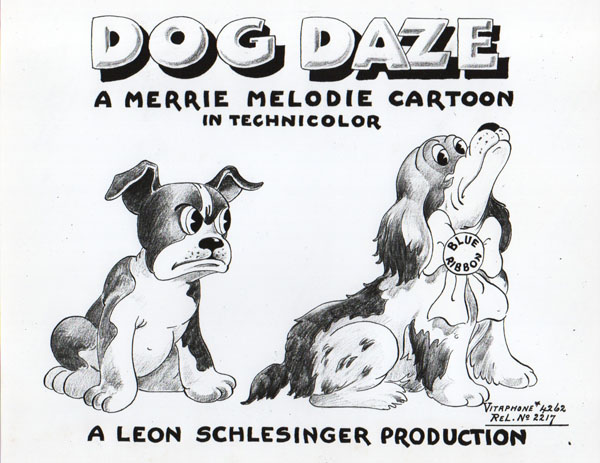
:
Dog Daze (9/18/37) – A pedigreed dog show becomes a canine vaudeville show, complete with blackouts, such as “Little Man, You’ve Had a Busy Day”, showing a panting dog at the end of a long line of telephone poles. How they got that gag past the Hayes Office is anybody’s guess!
Songs include “My Little Buckaroo” with special lyrics, sung by prairie dogs. Since the song is better featured in this film than in its own self-titled Merrie Melodie below, I’m putting the clip of the song (another from M.K. Jerome and Jack Scholl) from whence it debut (Cherokee Strip, 1937) here. This cartoon also has strains from “How Dry I am”, first performed by a sozzled St. Bernard, and then in falsetto by equally sozzled fleas who get into the dog’s brandy. “Puppchen” also again shows up.

I Wanna Be a Sailor (9/25/37) – Mama Parrot is trying to teach her children how to become cute “Polly Want a Cracker” types, but little tough guy “Petey” wants to be a sailor, upsetting his mother no end. Seems that Poppa Parrot, also a sailor, didn’t want to stay anchored in one port more than five minutes – and left the family high and dry! Petey tries a sailing adventures which goes very much awry, in the company of an over-talkative yellow duck.
Songs: “Old Black Joe” (sung by Mama as she goes out to rescue her son), and “I’m the Captain’s Kid”, a specialty for Sybil Jason from her feature role in The Captain’s Kid (1936).
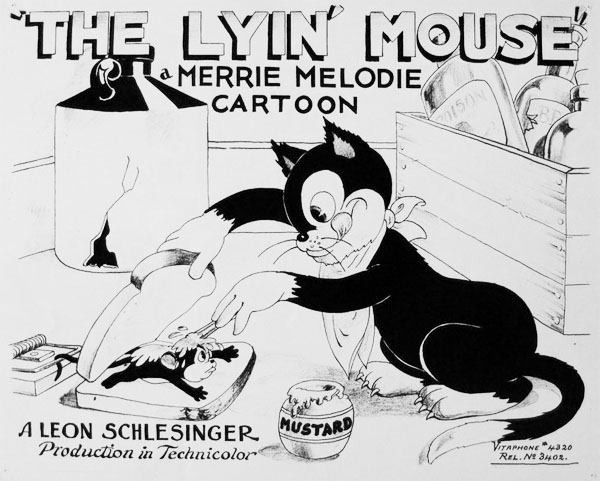
The Lyin’ Mouse (10/16/37) – A mouse tries to get out of being eaten by a cat by telling him the story of the lion and the mouse. The cat allows the mouse to escape – only to be given the razz by the mouse, “Sucker!” This may also be one of the first films to use the reversal of the old act of a man putting his head in a lion’s mouth. Songs include “How Could You?”, “Animal Fair”, “Congo”, “Am I Blue?” and “The Little Old Fashioned Music Box”.
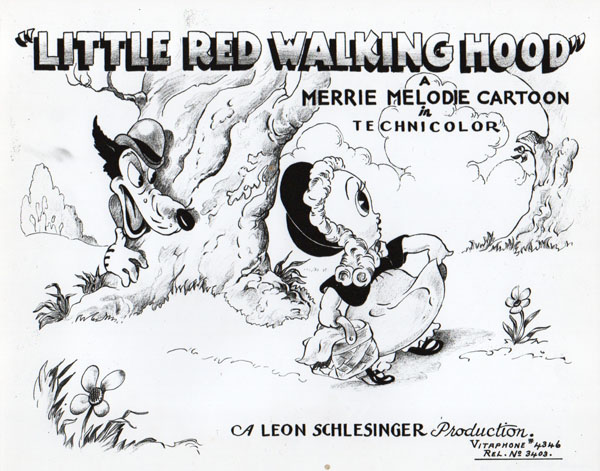
Little Red Walking Hood (11/6/37) – one of Tex Avery’s first fairy-tale takeoffs, spoofing all the usual tropes of the “Riding Hood” story except for the lack of a “Red Hot” version to come later. Features recurring appearances of Egghead, as the surprise “hero of this picture” at the finale (a gag to be later lifted verbatim in Droopy’s Wild and Wolfy). Songs: “Gee, But You’re Swell”, delivered by the wolf in talk-sing manner to lure her to his car, which is fully equipped for seductions – right down to the “Automatic Wink” and a revolving license plate “07734″, which, upside-down, reads “Hello”. The song was recorded for Victor by Benny Goodman, Chick Webb for Decca, and Teddy Wilson in small combo and Miff Mile in mid-sized band, both for Brunswick.
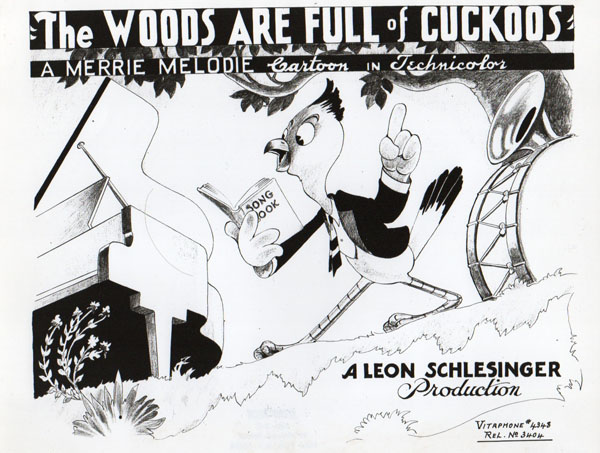
The Woods Are Full of Cuckoos (12/4/37) – A radio revue, taking off on Gillette’s Community Sing radio show of the 1936-37 season, which was hosted by Milton Berle and included a young Eileen Barton (who has been written up in a “Radio Roundup” article on this website before) playing a sponsor’s daughter. Mostly funny animal takeoffs on celebrities. (One of the most obscure caricatures is possibly the only use of Haven McQuarrie, host of a radio amateur show, “Do You Want To Be an Actor?” on NBC Sunday nights 8:00 to 9:00 – here appearing as “Raven McQuandry’, and receiving in answer to his title question a resounding “NO!” from the audience.) The title song does not seem to appear in any commercial recordings, but provides another excuse for the feud between Ben Birdie and Walter Finchell from The Coo Coo Nut Grove. Other songs include “Love Is On the Air Tonight” from “Varsity Show”; and “How Could You?” given to donkey singer “Moutha Bray” (Martha Raye).

September In the Rain (12/18/37) – Midnight in a grocery store, with the labels on all the packages coming to life. Some gags taken from How Do I Know It’s Sunday, Billboard Frolics, and other early cartoons. A sequence of Fred Astaire and Ginger Rogers appears to be partially rotoscoped. Additional often censored scenes include caricatures of Al Jolson in blackface, and Fats Waller and Louis Armstrong as the Gold Dust Twins. (The cuts typically leave the running time on this short at approximately four minutes in most screenings!) The title song is already discussed above. “Nagasaki” also appears again.
Daffy Duck and Egghead (1/1/38) – The color debut for Daffy Duck (in full Technicolor, over a year before Porky Pig would get his chance at a full spectrum). Egghead goes duck hunting (he should know better than that), and faces off against Tex Avery’s early screwball version of the Duck with many hilarious repercussions. Songs include “The Calm from the William Tell Overture, “The Lady In Red”, “Bob White”, and the new Looney Tunes theme song, “The Merry Go Round Broke Down” in a full verse production number by Daffy with special material lyrics. With its original lyrics it was recorded by Jimmie Lunceford for Decca, Dick Robertson for Decca, Gene Kardos for Melotone et al., and Shep Fields for Bluebird. The number gave arrangers great opportunities to include dissonances allowing the orchestras to play off-key. Also recorded in England by Billy Costello (the original voice of Popeye), in a recording that was written up by Jerry Beck back in his days at Cartoon Brew.
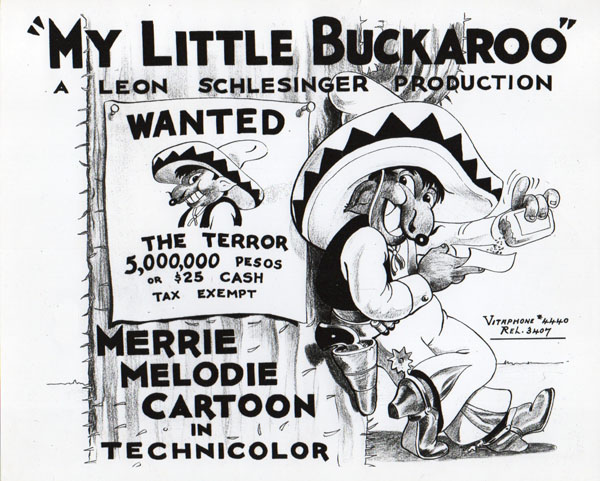
My Little Buckeroo (1/29/38) – For a change, we are presented with a pig who is not Porky – instead sounding like Western sidekick Andy Devine. (Andy once appeared on the Art Linkletter show in the sixties, claiming that he had the same nodes on his vocal chords as Bing Crosby – except Bing’s were in tune! He was also well known for frequent guest appearances on The Jack Benny Program, as sidekick to “Buck Benny”.) The cartoon also features a Mexican stereotype bandido, and a horse who prefers sliding down a hillside to chasing bandits. The “Andy” pig “croons (???)” the title song, which was introduced by Dick Foran in Cherokee Strip (see above), and also recorded for the Western market by the Massey Family (also known as “The Westerners”, stars of the WLS National Barn Dance) on Melotone et al. Joe Haymes recorded a dance version on Melotone et al., Bing Crosby recorded it for Decca (below). Russ Morgan got it for Brunswick. Ambrose covered it for the British market on British Decca. And the song attained the status of a Western standard, being performed or recorded in later years by Roy Rogers and Dale Evans, Eddy Arnold, and Slim Whitman.
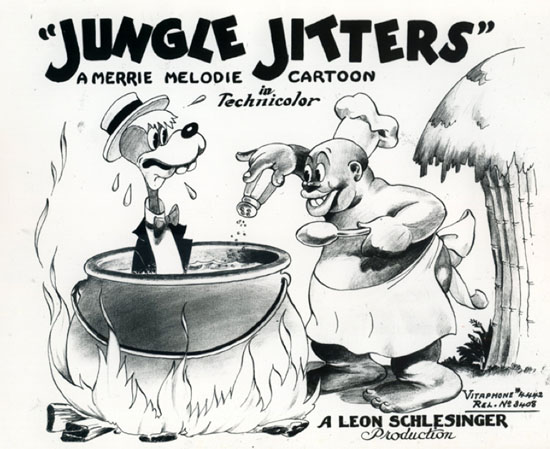
Jungle Jitters (2/19/38) – A slice of life in a village of African stereotype cannibals. which is being visited by a pushy door-to-door salesman (a parody of Al Pearce’s radio character Elmer Blurt). Also parodied is Al’s “Tizzie Lish” character from the same program, as the mysterious white jungle queen. (Parodies of her also appeared in The Woods Are Full of Cuckoos, discussed above, and in the previous “Porky’s Hero Agency” as the Gorgon.) The cannibals see the salesman as meat on the table, while the queen sees him as a prospective bridegroom. He brings to her mind visions of Clark Gable and Robert Taylor – but when he realizes he has to kiss her, he heads straight for the stewpot instead.
Songs include “Congo”, and a few snatches of “Vieni, Vieni”, along with a talk-sing version of Johnny Mercer’s “Too Marvelous For Words” with special material lyrics. “Too Marvelous” was introduced in Warner’s 1937 feature, Ready, Willing, and Able (see below). Bing Crosby recorded it for Decca. Chu Berry (a contingent of Fletcher Henderson’s big band) covered it on Variety records. Phil Harris recorded it for Vocalion. Eddy Duchin performed it for Victor, and Shep Fields for Bluebird. Ambrose also performed it for British Decca. The song attained the status of a standard, and received numerous later recordings, among them Tony Martin on RCA, and Harry James and Doris Day on Columbia.
The Sneezing Weasel (3/12/38) – A weasel tries to catch baby chickens at a poultry plant, only winds up catching a heck of a cold instead. Songs in underscore include “Bob White” and “You Can’t Stop Me From Dreaming”, which was recorded by Guy Lombardo for Victor, and Ozzie Nelson for Bluebird.
A Star is Hatched (4/2/38) – Nearly a retelling of Let It Be Me, except that this time, the same hen gets it into her head that she wants to be an actress, rather than chase radio crooners. Cameo appearances include W. C. Fields and Charlie McCarthy, and a production number by “Dick Fowl” directed by “Buzzard Berkeley”. Ends almost identically to Let It Be Me, with the hen’s hatchling doing a Katherine Hepburn impression and getting smacked for it. Songs include “I’ve Hitched My Wagon To a Star” and “Hooray For Hollywood” from “Hollywood Hotel”, “California, Here I Come” as cue while she hitchhikes, “You Ought To Be In Pictures”, “Arkansas Traveler” to set the rural scene, and a medley of “Don’t Give Up The Ship” and “Song Of the Marines” for the production number.
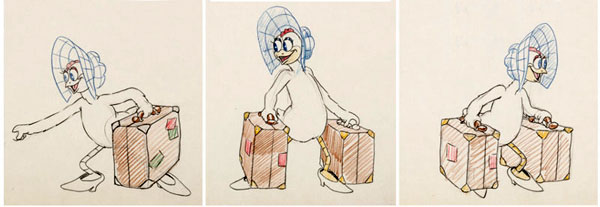
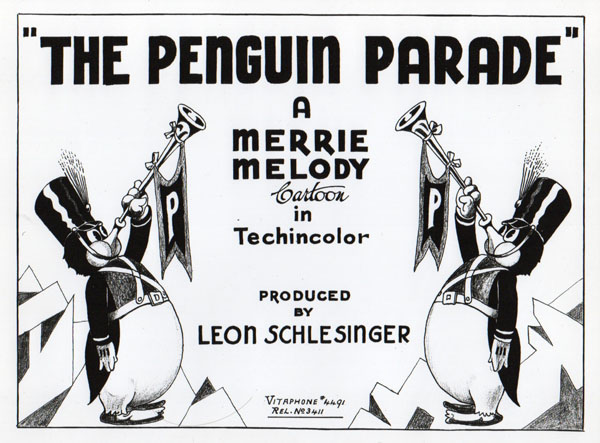
The Penguin Parade (4/16/38) – A musical revue set at a south Pole nightclub. A notable gag has a penguin order a Scotch and Soda with a lemon twist – and receive it in an internally efficient manner as all ingredients are tossed into him, then vigorously shaken to provide the intoxication. Title song is an original by Byron Gay, who receives screen credit on the titles (not known to have been commercially recorded). “When My Dreamboat Comes Home”, and “Bei Mir Bist Do Schon” also appear.
Now That Summer Is Gone (5/14/38) – Another “little boy gone astray” cartoon from Frank Tashlin, following a little squirrel’s addiction to gambling, and his father’s rather violent reaction. Caught in the act by way of dad’s clever ruse, the squirrel hears dad threaten “I’ll give ya’ ten lashes so you’ll not forget”. “Ten lashes”, ponders sonny boy, who makes pop a proposition – flip for it, “double ot nothing”! Pop instead administers the punishment anyway, which continues to be heard over the closing end card. The title song was recorded fairly widely. Victor gave it to Guy Lombatdo and his Royal Canadians. Bluebird had Shep Fields and his Rippling Rhythm. Brunswick gave it to Red Norvo with Mildred Bailey, and Decca gave it to Woody Herman’s brand new band. Other songs include “September in the Rain”.
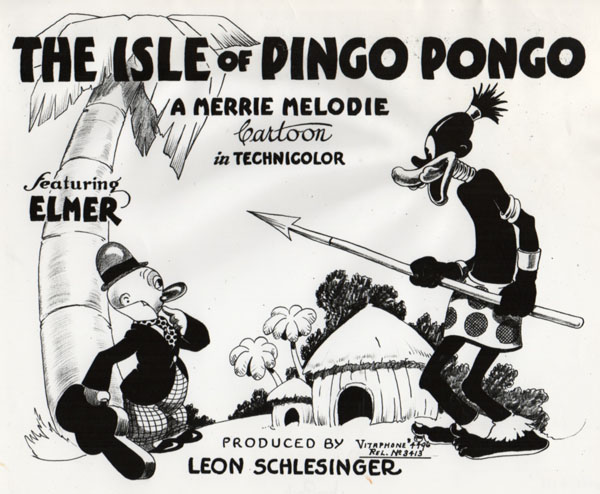
The Isle of Pongo Pongo (5/28/38) – One of the “Censored 11″, and Tex Avery’s first spoof of MGM’s Fitzpatrick Traveltalks, with most of the cliches getting the razz. Songs include “Sweet Georgia Brown”, “Congo”, “Bei Mir Bist Du Schon”, “My Isle of Golden Dreams”, and “Aloha Oe”, as “the sun sinks slowly in the West”, with some assistance from Egghead’s blunderbuss.

Katnip Kollege (6/11/38) – The Swingology class at Katnip Kollege is really groovy, with the Crosby-ish professor “peckin’” to the beat. Only little Johnny does not get the modern beat – his idea of jive is “Vo-Do-De-Oh” and “Boop-Boop-a -Doop”. He is made to sit in the corner and wear the dunce cap, until a ticking clock gives him the swing beat.
Songs include “Working Our Way Through College” from Varsity Show, “Let That Be a Lesson To You” from Hollywood Hotel, recorded by Benny Goodman for Victor, and “You’re an Education”, which we will meet again for discussion in a subsequent Merrie Melodie. A featured production number, “As Easy As Rolling Off a Log”, has at least a brief appearance in Warner’s Over the Goal starring Johnny “Scat” Davis. Davis in fact appears on the track of this cartoon, and it is widely thought that a large portion of the track is an outtake from the aforementioned feature, pressed into service for the cartoon. Davis had become a name at Warner for his appearances in Busby Berkeley’s “Varsity Show” and “Hollywood Hotel”, and had a brief run of attempts to cast him as a featured star on his own.
NOTE: Worth reading is this recent Daily Beast article by Gary May (songwriter M.K. Jerome’s grand son) about James Taylor’s recent recording of “As Easy As Rolling Off A Log”.
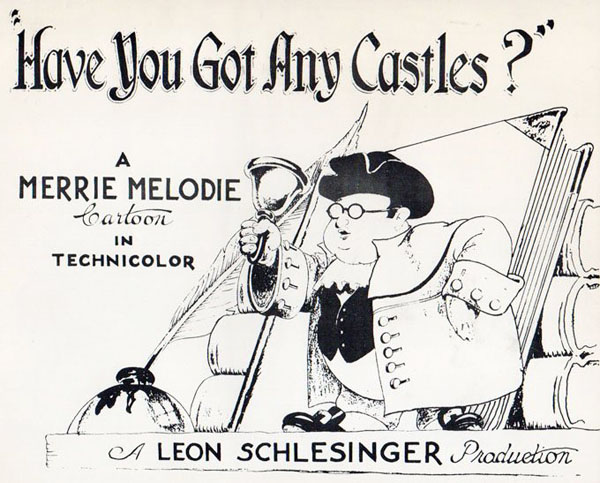
Have You Got Any Castles? (6/25/38) – Often censored in spots, though not classified as one of the Censored 11. Takeoffs on Alexander Woolcott as the Town Cryer were excised for many years in the Blue Ribbon reissue. Also often censored is a borrowed production number from Clean Pastures. Censored or not, the plot idea is another “Midnight In a Book Shop”. The title song is another number from Varsity Show, introduced by Dick Powell and recorded by him for Decca. Also recorded by Dolly Dawn and her Dawn Patrol for Variety. “Old King Cole” also appears from “Varsity Show”, recorded by Larry Kent and his West-coast based dance band on Melotone et al. “Swing for Sale” is the repeated number from “Clean Pastures”. The Pizzicato from Sylvia by Delibes (Carl Stalling’s go-to number when he needed a “pansy” dance) is performed by a quartet of classic horror monsters, including one of the few Fu Manchu parodies that still regularly appears in screenings.
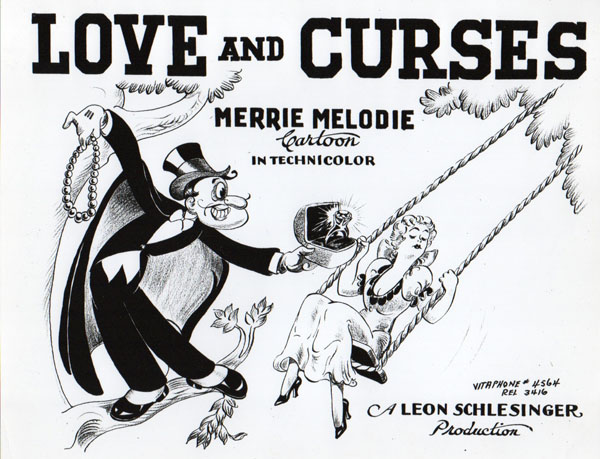
Love and Curses (7/9/38) – An old couple look through a photo album and reminisce about their flirtatious youth in the Gay ‘90’s. There was a blackguard back in the day, whom they remember too. He shows up for real at the end of the picture, and hasn’t changed a jot. A collection of old favorite songs provides accompaniment, including, “Put On Your Old Gray Bonnet”, “In the Shade of the Old Apple Tree”, “In My Merry Oldsmobile”. and “Love Me and the World Is Mine”, all big hits around 1905-06 except for “Bonnet” from a few years later. “Love Me and the World is Mine” was recorded by Albert Campbell for Victor, the Haydn Quartet for Victor, and Henry Burr on Columbia in the song’s heyday, and revived later in England by Josef Locke with Ray Martin and his Orchestra on English Columbia.
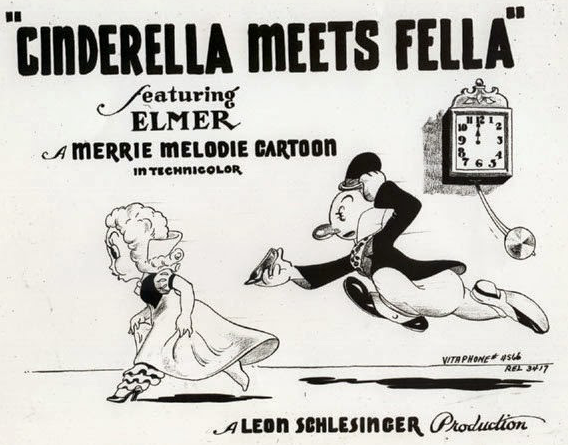
Cinderella Meets Fella (7/23/38) – Tex Avery gives the Cinderella tale the razz. It turns out the Fairy Godmother is well “lubricated”, while the prince turns out to be Egghead in something of a Joe Penner mode. Songs: “About a Quarter to Nine”, “With Plenty of Money and You”, “You’re an Education”, “She Was an Acrobat’s Daughter”, “The Kiss Waltz” (a 1930 pop song Carl Stalling remembered a couple of times), among others.
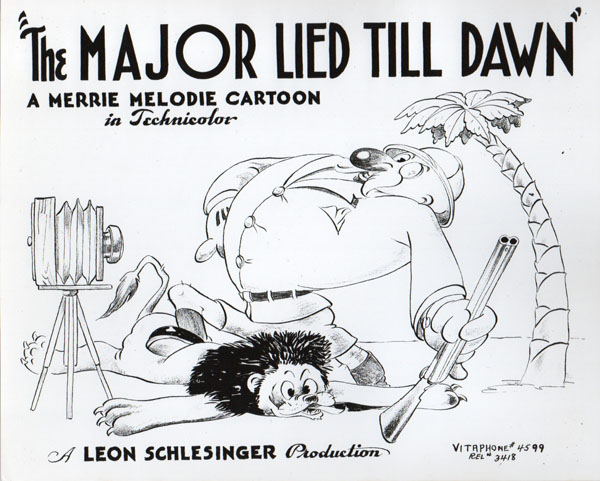
The Major Lied ‘Til Dawn (8/13/38) – A pompous C. Aubrey Smith-type Major is explaining to a Freddie Bartholomew-type kid about his study full of hunting trophies, each trophy having a tall tale attached to it. An allusion is made to Max Fleischer’s most popular cartoon series, as the major subdues a stampede of wild animals with the use of a spinach can – “By jove, if it’s good enough for that sailor man, it’s good enough for me!” The major also brings up an elephant having trouble remembering something. The elephant finally remembers it at the end of the cartoon, and says it – “That’s All Folks”. Songs: “Vieni, Vieni”, “Congo”, and Von Suppe’s “Poet and Peasant Overture, “Bei Mir Bust Di Scoen”, and Sissy”.
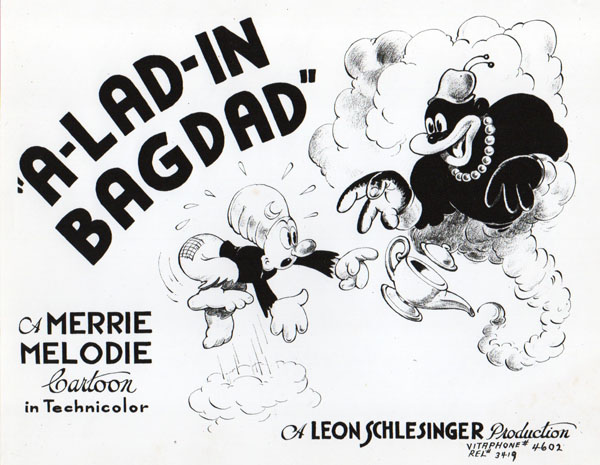
A-Lad-In Bagdad (8/27/38) – Egghead (in his first appearance without Tex Avery) gives Aladdin’s Lamp the lampoon. Egghead uses his genie wishes to perform for a sultan and impress a princess. She’s not so impressed once she gets to know him (“I’ve been swindled”), and disappears with the genie. A parody appears at one point of Billy Jones and Ernest Hare (The Happiness Boys), who perform a mock parody of their theme (endlessly repeating “How Do You Do and How Are You”), only to be dropped through a trap door by the Sultan because they won’t shut up. Ken Harris would probably remember this setup years later when he directed “Hare-Abian Nights”.
Songs include “Day Dreaming (All Night Long)”, recorded by Rudy Vallee for Victor, “Something Tells Me” (which we will meet again in a forthcoming article, to be discussed later), and a production number by Egghead of “Bei Mir Bist Du Schoen” – which was a huge hit by the Andrews Sisters in 1937.
NEXT POST: the 1938-39 Looney Tunes – a season where black-and-white cartoons were not as thick on the ground as they had previously been.
NOTE: For those of you just joining us in this survey, you can check out our earlier Looney Tunes and Merrie Melodies posts by clicking here.


 James Parten has overcome a congenital visual disability to be acknowledged as an expert on the early history of recorded sound. He has a Broadcasting Certificate (Radio Option) from Los Angeles Valley College, class of 1999. He has also been a fan of animated cartoons since childhood.
James Parten has overcome a congenital visual disability to be acknowledged as an expert on the early history of recorded sound. He has a Broadcasting Certificate (Radio Option) from Los Angeles Valley College, class of 1999. He has also been a fan of animated cartoons since childhood.












































Radio Daily of March 10, 1937 mentions:
J. Fred Coots telling everyone about his latest song, “The Woods Are Full of Cuckoos,” which he wrote with Charley Newman and placed with Harms.
Billboard plugged the song the following month but I haven’t found anything indicating it appeared in a feature.
That musical number from “Ready, Willing and Able” really is “too marvelous for words!” I love the giant typewriter set, and the novel use of typewriters as percussion instruments. The most famous example of that is Leroy Anderson’s 1950 composition “The Typewriter” for solo typewriter with symphony orchestra, a favourite of the Boston Pops under Arthur Fiedler. It was later used in the 1959 film “But Not for Me” starring Clark Gable, into whom the Elmer Blurt salesman was transformed by the jungle queen’s imagination in “Jungle Jitters” to the strains of “Too Marvelous for Words”. Anderson’s “Typewriter” was also featured in the Jerry Lewis comedy “Who’s Minding the Store?” as well as an episode of “Here’s Lucy”.
Does anybody remember “Bei mir bist Du schoen” being used in a root beer commercial?
.
Long before Leroy Anderson did, the French composer Erik Satie used a typewriter in an orchestral piece in the 1920’s. I’ve heard it, but unfortunately I can’t remember the title. The eccentric Satie wrote mainly for the piano, and he was noted for giving his works oddball titles like “Flabby Preludes” and “Bureaucratic Sonata.” It’s possible that Anderson got the idea for his own “typewriter music” from Satie.
It is possible, Rollo, and Anderson would at least have been aware of Satie’s work. You’re thinking of Satie’s ballet “Parade”, which was first performed in Paris in 1917 by Sergei Diaghilev’s Ballets Russes, with costumes and set design by Pablo Picasso. However, Jean Cocteau, who wrote the scenario for the ballet, added the typewriter and others noisemakers to the score over Satie’s objections, so he deserves credit for that particular innovation. Cocteau wanted another scandal like that created by Stravinsky’s “The Rite of Spring” a few years earlier — and he got it!
Great post. I Wanna Be A Sailor was always my favorite when I was a kid. I believe “We’re Working Our Way Through College” plays through the first scene of Maw teaching her children.
This was the season when at least some of the Merrie Melodies got away from the problem Friz Freleng complained about, where the cartoon would have to stop dead for a musical number, and started figuring out better ways to either incorporate the music directly into the story, or have the music be used more in the background, so it didn’t interfere with the story. It’s also the first full season with Mel as lead voice-man for the cartoons, and Tashlin really gives his voice a workout (both in speaking and singing) in “The Woods Are Full of Cuckoos”
They used to show a lot of these on TV all the time. Nowadays, Now That Summer Is Gone and maybe Daffy Duck and Egghead are the only ones that get steady airplay. I Wanna Be A Sailor, in particular, I haven’t seen in years. Warners seems to be favoring the ’40s and ’50s shorts, when the Looney Tunes style as we know it now was firmly established, and ignoring the formative ’30s cartoons, when the studio was still finding its groove. These cartoons still have a certain charm, and ethnic stereotypes aside, are still enjoyable today.
Draft Beer, Mr. Shay’s.
“The Soubrette on the Police Gazette” by M.K. Jerome, first heard in the 1936 short “The Sound Round-Up” (and later one of the musical numbers in 1952’s “The Big Trees”), also played in “Dog Daze”. It was later heard in “The Gay Anties”.
Great post. As perhaps one of the few who has seen these with audiences I can say that they went over well.
The Major Lied Till Dawn also featured a new, more confident arrangement of Merrily We Roll Along which ended the experimentation of the first few years as the Merrie Melodies signature tune. With some minor tweaks here and there, this was THE theme until 1941.
Dear Sir…..yours posts are pure heaven….and MUCHLY appreciated!!!
Going over to the Daily Beast side and clicking on the audio for “As Easy As Rolling Off a Log”, I noticed the vocals on the audio track here are not exactly the same as the vocals for the same part of the song in the cartoon. Since the audio was supposed to have come from the edited-out version of “Over the Goal”, I wonder which version was the final one cut and which was the alternative recording of the song.
Almost every Merrie Melody of the 1937-38 season is solid. Dog Daze has always been a personal favorite of mine. Love And Curses is really the only miss. It doesn’t feel like a WB cartoon, despite it’s sound premise for one.
When I first saw Hollywood Hotel, I was surprised on how Johnny Davis’ handsome appearance contrasted the meek looking character he voiced in Katnip Kollege. Such a shame his acting and singing career didn’t last very long. A lot of solid talent there.
The Woods Are Full Of Cuckoos could have its own article explaining all the now-obscure pop culture references. (Ditto for Tashlin’s book-come-to-life cartoons).
Out of curiosity, where can these lobby cards be found? They’re so fascinating to look at. It’s great to see that a lot more are continuing to surface.
I’ve been collecting these Lobby Cards for 40 years. There is no specific place to find them. They are very hard to track down. Warner Bros. does not seem have them as far as I know (I asked). I have about a third of them in my personal collection and I’m using them to illustrate these posts. I’m glad you enjoy them.
I’m hoping collectors who might have the missing cards for Sneezing Weasel, A Star Is Hatched, Daffy Duck and Egghead and Now That Summer Is Gone will come forward and contribute them to the post.
These posts are so enjoyable. It’s fun to seek out the songs we’ve loved for so many years.
Ruth Etting, by the way, is the popular ’20s and ”30s entertainer whom Doris Day portrayed in “Love Me or Leave Me” with James Cagney in 1955. It was a rather tough, manipulative, hard-bitten role, at least for Day, who was superb with Cagney and Cameron Mitchell in a rare non-villainous role..
The release number I see on “Speaking of the Weather” is incorrect. That should be 2217, not 2216. I think “A Sunbonnet Blue” was 2216. “Dog Daze” was probably 2218.
~Ben
I’m Jim Ames of Cartoon Renewal Studios – We’re restoring all the off copyright cartoons to brilliant 1080 HD so they can be enjoyed forever – https://www.youtube.com/watch?v=ot0NzzerUSs&list=PLzJj4oNyshJaNrC2pSM1yzST9LwUusgGW